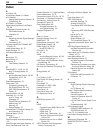
114 Appendices114 Appendices
IEEE 1394 Recording
Symptom Remarks
1. Program to be recorded was correctly
selected from ChannelView, however, incor
-
rect program was recorded.
The broadcaster supplied program information that was incorrect
and/or was changed after a recording was added to the Record
List.
2. Incomplete ChannelView program recorded. Recording device may lack sufficient blank space to make a full
recording.
3. ChannelView program recording failed. • Connection and compatibility issues with IEEE 1394
(FireWire®) digital devices. This may include too many
Firewire devices in use at one time, or the recording device
not understanding the record command.
• Television lost power long enough to lose current clock time.
• TV energy Mode was set to Low Power. Change TV Energy
mode to Fast Power On. Press
MENU
, open the Setup menu,
highlight the Fast Power On radio button, press
ENTER
.
4. Cannot record to or from the IEEE 1394
device, including dubbed recordings.
• To initiate a recording to IEEE 1394 device, press the
(
RECORD
) key. The Record menu displays allowing setup of the
recording.
• The source device for the recording is not powered on.
• When dubbing, the destination device for the recording is not
powered on.
• The wrong medium (analog tape for digital recording, or
digital tape for the analog recording) is in the device.
• The program is copy protected.
• The program has already been recorded once and the copy
protection only allows one recording.
• Unapproved source device for copy protected material.
• The recording device can not decode the copyright signal
included in the signal source (try another device if available).
• The playing device (for dubbing) does not support copy-
righted material.
• Source for recording is copyrighted
• Too many IEEE 1394 devices in network. Insufficient band-
width available. Disconnect unused devices.
• Source Device has higher communication speed (S 400) than
record device. If possible, reverse devices, play in the slower
device and record in the faster device.
Appendix D: Troubleshooting, continued
IEEE 1394 Devices
Symptom Remarks
1. Excessive digital artifacts appear when
viewing an IEEE 1394 device.
• The IEEE 1394 cable is too long; 15 feet between devices is
the maximum.
• There may be a slow device in the middle of the IEEE 1394
network. Move the slow devices to the end so that connec
-
tions for faster devices do not pass through them.
2. D-VHS recordings for digital cable have
drop-outs (loss of picture or sound), or no
playback.
Digital cable signals on IEEE 1394 can exceed the data rate stan
-
dards supported by DVCR.
3. The IEEE 1394 Device is no longer listed in
the Input Selection menu.
• The IEEE 1394 plug is disconnected or loose.
• The IEEE 1394 device has not been powered on. Turn on.
• The device has not been discovered.
• The device is not an audio/video device
4. MENU button does not display a menu. • The IEEE 1394 device does not provide a menu.
• The TV cannot support IEEE 1394 menus.


















